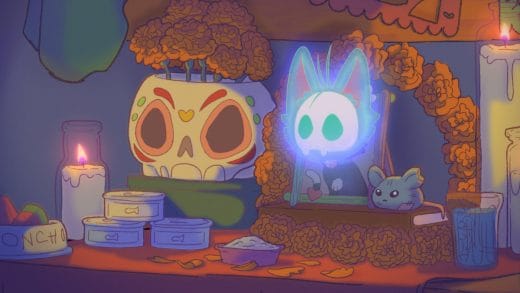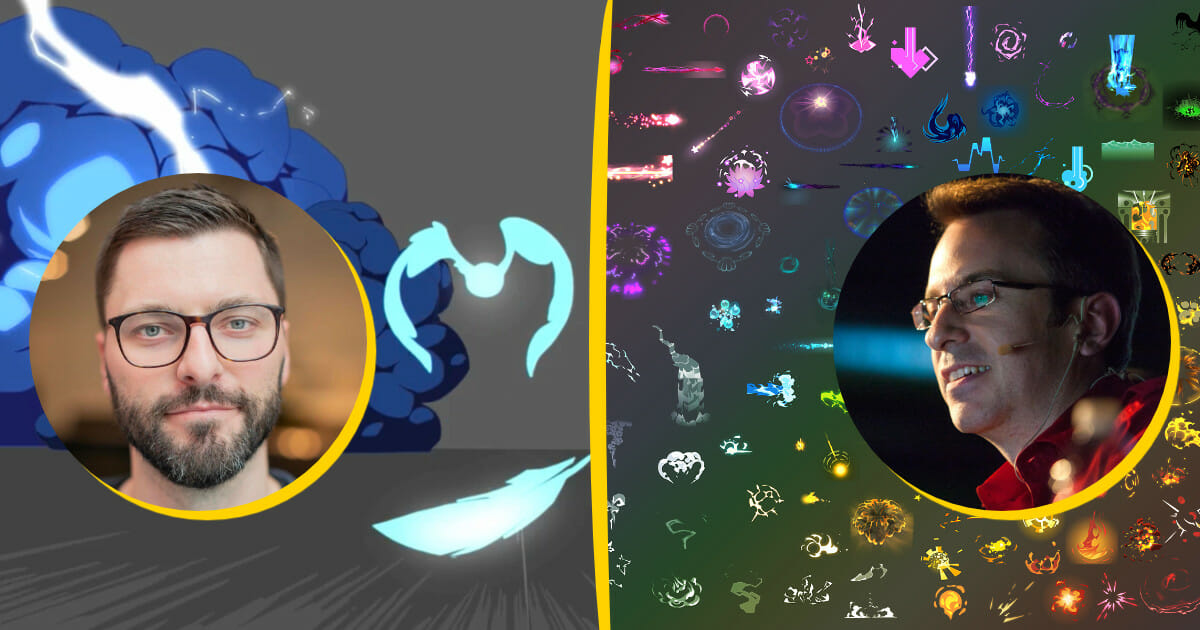
What are 2D FX? When you think of moments that dazzled you in your favourite video game, animated series, or live-action film, many of those effects were made using drawings and clever compositing. While viewers may experience these special effects as magic, real stage magicians study and work to make performances look effortless. Similarly, a studio’s visual effects department plays a valuable role in making scenes more believable and helping the audience suspend their disbelief.
We invited two visual effects wizards to break down the techniques and tricks behind spellbinding visual effects. Jason Keyser is a 2D FX and 3D VFX artist who worked on titles like League of Legends, and now runs the highly informative VFX Apprentice academy. 2D FX artist Chris Graf learned his craft on iconic shows like Happy Tree Friends before going on to co-head the 2D FX department at JamFilled studio, where he lends his talents to shows like Final Space and DC Superhero Girls.
Both of our guests pull back the curtain into what life is like in the 2D FX department for leading studios. They point to a positive outlook in their cards, as effects are recognized as increasingly important across animation and gaming. Jason and Chris share how they approach their work, how they stay inspired, and parting advice for future visual effect masters.
If you don’t want to know the secrets behind their act, look away now!
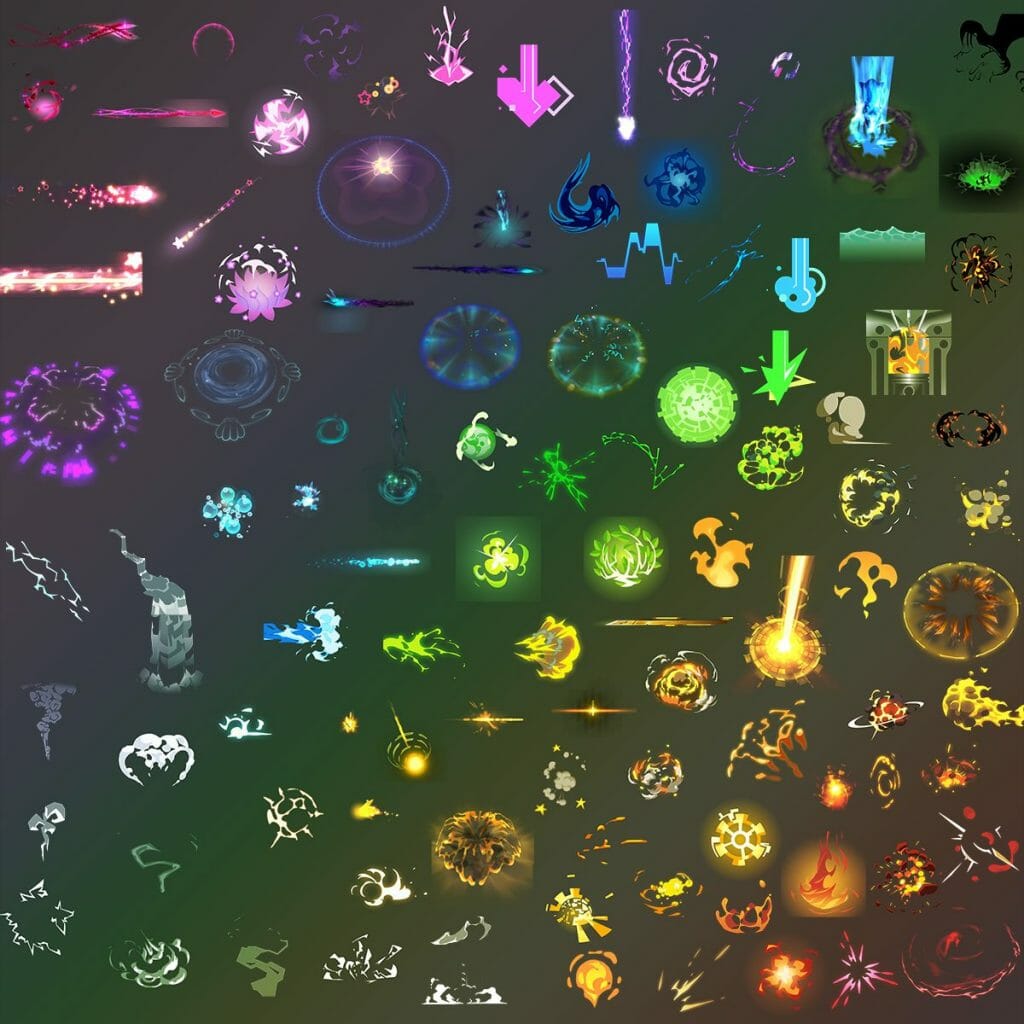
Hi Jason, can we hear a little about you and your story?
I’ve always loved to draw, but never knew much about the animation industry until I got to college. That’s really the first time I was around others who were more passionate than me with art. I had a lot of catching up to do! My first year, I wasn’t qualified to get into the animation program at my university, so I dove into practicing my art skills day and night. I filled up many sketchbooks that year, and landed somewhere in the middle of the pack of 15 students that were admitted to the program the following year. From there, I decided to take a break from playing video games, which gave me back a ton of extra time and focus to practice animation. Soon, I was picking up small animation jobs at local startup studios, and I landed a stable job while working on my two senior projects, Alight and Dream Giver. I graduated in 2011.
The stable job turned full time after graduation. I was working on Animal Jam, a National Geographic Kids game where I created 2D animation, prop design, and FX. Of course, the FX were my favorite part! I also picked up multiple freelance gigs after hours and on weekends. Between all the projects I was involved in, I was able to land a job as a VFX concept artist at Riot Games, where I soon transitioned into a 3D VFX artist. I basically learned game FX on the job. That experience prompted me to start teaching the way I had been taught over the years, which led to a YouTube channel, and now VFX Apprentice, which I have been focused on full-time since leaving Riot in 2020.
With VFX Apprentice, you’ve created a vast library of learning resources for VFX artists. What is a key piece of wisdom you share with your students?
Yes, there’s a lot to learn as a VFX artist (often called an FX/VFX animator or visual effects animator, depending on the studio). The thing is, everything we do is based squarely on foundational principles of art, design, and motion. So when you see the shiny fancy library of lessons with everything there is to learn, just know that every amazing piece starts with one good drawing. If you’re feeling overwhelmed by the wall of information, just step outside and draw some plants. They’re full of motion and rhythm and design. The inspiration for many FX will develop as you practice daily, building up that visual library in your mind.
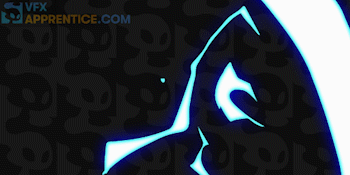
Many of your lessons at VFX Apprentice are geared towards criteria looked for in projects by game development studios. How important are VFX artists in the gaming industry today?
You can’t see it right now, but I’m hunched forward, intensely typing my answer to this question! I have all the urgency in the world to get this simple message out: Games, television, and film are all desperately searching for top-tier FX and VFX artists. This has been a prolonged need for many years, and there have never been enough artists to fill all the openings at studios. From talking with my colleagues all around the world, across all of the entertainment industry, these skills just aren’t being taught, so the job openings remain open for months or even years. Okay, so that’s the market demand showing how important artists like us are. The interesting question is, “Why?”.
Imagine your favorite epic magical climax sequence in a game or movie: Say, when Saitama punches in One Punch Man, or when Lux fires her Final Spark ultimate ability in League of Legends. Now imagine that sequence without any flashes of light, no dust or debris, no fiery embers or charred stone. Just characters falling back crying out. It’d be like watching kids playing pretend out on the grass. Visual effects sit at the apex of emotional resonance in a story arc. They take what is happening already and amplify or elevate the emotion to a fantastical realm of imagination.
Think of some of the sharpest spikes of awe you feel in real-life: Lightning bolts in a vicious storm. Fireworks exploding right above your head. Tidal waves crashing on the shore. The tragic heat of a building burning down. These are real-life effects! They are wild and uncontained forces in the natural world. As FX artists, we wrangle the uncontrollable into dynamic storytelling.
Games like League of Legends and Valorant must require many talented VFX artists to bring their worlds to life. What’s a typical day as an artist on these titles?
The bigger the game and its team size, the greater the need for a collaborative work style. VFX artists on these teams handle a mixture of team-based work, and individual contribution work. Typically, there will be some regular kind of “stand up” meeting, where everyone working on a common part of the game, say new characters or environments, comes together to share their progress. This helps everyone else understand how things are moving along, so they can follow up after with requests and ideas to make the product better. Those might lead to additional meetings, depending on how many people are involved. Then of course there’s actually making the VFX! That’s just a matter of focus time, zoning out, getting into the flow, making awesomeness. Whenever the artist is at a good point to share progress, they can gather feedback from their colleagues, either in a review meeting, or asynchronously by posting on a digital review platform. Of course, for all the great artists I’ve ever known, work doesn’t really end after work, because the creative flow follows you around long after you’ve shut down your computer. I’ve spent countless nights laying awake in bed solving creative challenges in my mind. Then I wake up the next day to see where it all leads!
How many artists do you work with on your team, and what do you look for in a teammate?
When I was at Riot Games, our teams were quite large. There were artists specialized in all the disciplines: Illustrators, character & environment designers, character & environment 3D artists, riggers and technical artists, character animators, audio designers, and of course, VFX artists! Every one of the artistic craft disciplines looks for one thing in common: A firm grasp on the artistic fundamentals. It doesn’t matter how good your polish work is if the artwork beneath it fails on a foundational level. So a fully colored, fully-rendered, fully composited, fully finalized bad drawing is still just a bad drawing. I’d rather see multiple pieces that all demonstrate foundational mastery with just one polished piece, rather than many polished pieces that fall apart in their foundation.
For VFX on League of Legends specifically, we always looked for a certain kind of portfolio. Our needs on that project were so consistent, we made a style guide that anyone can aim for in their portfolio work. VFX Apprentice’s gaming VFX lessons are heavily built on principles shown in that style guide. That being said, each studio is different! I encourage students to determine which studio, which projects, which styles appeal to them personally, and gear their portfolio toward that passion. The best way to catch the attention of a studio is to make your portfolio compatible with theirs. So I recommend getting this advice from someone at the studio you want to work at, because it’s always different depending who you ask!
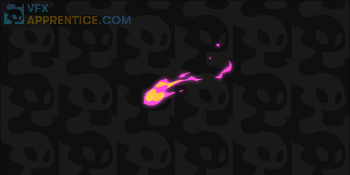
How do you approach it visualizing magic spells and impacts?
Like most art forms, it’s best to do the loosest, most creative work up front, so as I begin to descend into increasingly technical, tighter, more refined passes, I can rest assured that I’m building on top of a strong artistic foundation. So that initial pass is probably going to be a group of loose thumbnail sketches. Then if it’s a 3D effect, I’ll try to slap together some really basic block-in particles with little detail. If I can get a bunch of grey squares and circles to look good in motion, then the fully textured and colored version is likely to succeed as well. For a 2D effect, it’s good to stay loose and rough in the early stages. Those first few sketches are critical! I’ll pick my favorite and expand on it a bit, taking time to sit back and plan out the effect, its composition, timing, rhythm, and shape relationships. Those few extra minutes at the beginning can save hours later on!
When conveying elemental effects which reflect the real world, how do you make it convincing?
It all depends on the context. If the surrounding environment has dirt on the ground, it’s definitely a good idea to kick up some dust! Or if the source of the energy is magical, it’s a great idea to add subtle little embers spiralling off away from the effect out into the environment. Then of course for any aspect that’s not casting its own light, I need to make sure that it’s receiving the same lighting as the environment around it, or at least make it feel like it’s lit by a core of energy within the particle system itself. Really, anything that ties my FX work to its surroundings is a big help toward making the whole illusion convincing.
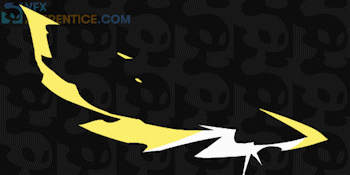
With artists animating in similar software, styles, and methods, how do you continue to come up with unique ideas?
I always say: No two VFX artists tackle the same effect the same way. It’s really perfect for someone who doesn’t enjoy doing the same thing twice. That means we’re always finding new and interesting techniques and approaches to similar problems. It allows a lot of leeway as a creative person. So as we work around each other, we provide this sort of bottomless well of knowledge and ideas. Kinda like being back in art school, getting inspired by all the talented classmates taking unique approaches on the same assignment.
What do you think is next in VFX? Are there any trends or innovations you’re pioneering?
There’s always a new batch of impressive tools and techniques that get released each year. So many things to keep up with! I think the best innovation is learning how to take all the high-end technology and infuse it with a truly artistic vision and execution. That’s really what we double-down on at VFX Apprentice: We’re not just teaching our students how to make next-generation art; we’re also training them to be classically informed, so their artistic foundation shines through in whatever tools they use throughout their career.
Thanks, Jason!
Introducing Chris Graf! Can we hear about you and your story?
I’m from a small town of around 800 people in Saskatchewan called Watson. I was always the kind of kid who could draw and I spent a lot of my free time drawing and learning from comics.
After High School, I moved to Saskatoon, SK where I took a Graphic Arts course which was sort of interesting, but not the creative outlet I was really hoping for. I took a couple years off and started taking life drawing classes and art lessons with various instructors until I found out about this animation college in Saskatoon called Red House, sadly now closed. Once accepted, I spent 4 years learning 2D classical animation, 2D FX (which I loved), painting, life-drawing, sculpting, layout and composition, and even stone carving. It was a great experience and something I was really passionate about.
After college in 2006 I got a job in New Brunswick as a character animator for a studio called FatKat. My first job was working on a violent little cartoon called Happy Tree Friends. It was insanely hard work going from a college level of ability, to a full on industry level expectation. We had a quota of 30 seconds of animation a week which included having to do our own 2D FX and because of the 2D FX class I had at college, this gave me a bit of a leg up.
After 7 months on Happy Tree Friends I accepted a job with Mercury Filmworks in Ottawa, Ontario. I was hired as a character animator and worked on numerous TV shows. About a year later I applied for a position in the 2D FX dept. I got the gig, and have been a full time FX animator since. I’ve now worked for various studios in Ottawa as an FX Animator, Designer, Supervisor, and Dept Head. I even moved to Miami for a year to do FX animation in video games.
Currently I’m the Co-Dept Head for 2D FX at JamFilled Entertainment in Ottawa.
From an industry perspective, is this a good time to be in 2D FX?
Even though it’s a very niche department, work is booming! With the pandemic’s impact on animation, this is one of those rare circumstances where business is actually thriving. I’ve seen a lot of video game and game cinematics looking for 2D FX on top of 3D animation. I’ve also seen 2D FX done on top of live action while the need for 2D FX design on animated TV shows and feature films increases, not to mention the amount of streaming services all looking for fresh content. Again, great time to be in 2D FX!
2D FX in animation often visualizes elements such as fire, electricity and water. How do you approximate real world physics when animating?
There are a few things needed for solid 2D FX animation and I imagine this goes for VFX as well. You need to get in that habit of becoming an observer. I have hundreds of videos on my phone of slow motion fire pits and water drops. The more you work in animation the more you start seeing things in frames. You start to pick up on where the design of a splash needs to change from big sheets of water to negative spaces creeping in and changing those sheets into droplets.
Understanding these types of things with all elements is the first part. Second is being able to draw them. Design in 2D FX is incredibly important and maintaining solid design throughout is crucial. A lot of 2D FX are animated straight ahead, which means there are no key drawings to map out your work: you go from one drawing to the next going with the flow and seeing where you end up. Usually FX is done this way because the nature of most elements can change drastically from beginning to end. The beginning of a splash looks completely different to the end of one. For me, I find trying to key these things out makes my animation look forced; It lacks the same flow. As the nature of an element can change so much over the course of a very short time, maintaining good design throughout is a big challenge, but a fun one!!
Once you have an understanding of gravity and the physics of an element, and you’ve locked down designs, you can start to push the timing and spacing of your animation, get more ambitious with your designs, and start thinking more about composition and how your FX can stand out more. This is definitely the fun part.
In clips Sprite Fight, Owls Prey and Larpers4life on your Vimeo, you use 2D FX to create magical elements. What possibilities do effects unlock here?
Haha, I had so much fun animating Larpers4Life! My friend videoed these guys out of his apartment window while they practiced their sword techniques. I thought it would be a lot of fun to add the fire and electricity visuals that they were probably wishing were real! In terms of possibility unlocked here, I think in this situation the world is my oyster. It brings a rather mundane looking video of a couple guys fooling around with their swords to life. Also brought to life thanks to the sweet sound design my buddy Sean Thornton added. But It’s suddenly so much more than what it started out as. I love the idea that whatever I can think of I can animate and add to a situation like this.
With Owls Prey, I was really trying to play around with animating the camera. Something we don’t do a lot of in a tv production because it’s hard and expensive to replicate. But in my own time, animating a camera at a birds eye view rotating and coming down to ground level while tracking explosions and bird flight was a challenge I just really wanted to take on. The only thing I think I was trying to unlock here was more experience with dynamic animation. Something seen a lot in anime, but not so much over here.
You mentioned that 2D FX can help to recreate the feeling of older, hand-drawn animation. Can you elaborate on this?
2D FX animation is classical animation. I use all the same techniques I would if I was animating with a pencil and a stack of paper. The upside to having a Cintiq and a powerful drawing program like Toon Boom Harmony is that I can have high quality finished work in the same amount of time as I could with roughing out my animation with the paper approach. Except with paper, I’d have to scan it all in, make sure the timing is working, do fixes, then clean up, scan again, and then colour. The old way is mind-boggling.
The shows I work on at JamFilled are all animated in Harmony. We have a talented dept of build artists who create elaborate rigs for the animators to use. Each part of the body gets a library of parts to switch out during animation to give the sense of classical animation. Having 2D FX drawn on top of this puppetry style really helps to drive home the feeling of something special, like the old classics.
How important is hand-drawing as a skill in 2D FX?
In my case, very. I draw anywhere from 10-200 drawings a day depending on what I’m working on. For any VFX artist, I think drawing out the FX only increases their knowledge of where and how to push an effect to get something unique and stylized.
What features of Toon Boom Harmony do you find most useful when creating 2D FX?
I animate mostly using the brush tool. I think my favourite part of Harmony is how much you can customize the layout of the program. The way a build artist uses the program is completely different to the way I use it. And so our displays will be completely different to best suit our needs. Harmony’s drawing tools are really easy to use and the options for adding compositing like glows and blurs to your FX are instant.
What do you think is next in FX? Are there any trends or innovations you’re pioneering?
Hm, that’s a tough one. We’re always looking to innovate at JamFilled and create new solutions to challenging design problems. But that’s usually just part of the day to day. I’m constantly trying to push my animation and drawing skills. I wouldn’t say there’s anything specific I’m pioneering or innovating. I’m just tryin to grow as an artist and be a good Supervisor.
Lastly, do you have any upcoming projects you’d like to let our readers know about?
I’m currently working on a great new show for Netflix called InsideJob. Lots of cool FX in this show! I had a small hand in 2D FX for the Marvel What If…? series, and I’m currently freelancing on some very cool things I can’t talk about yet with a studio called Double Plus.
Thanks, Chris!
See more spellbinding work from Chris Graf’s on his Vimeo channel. Explore a library of knowledge at Jason’s VFX Apprentice academy on YouTube. Read about other jobs which contribute to animated productions on the Toon Boom blog.






